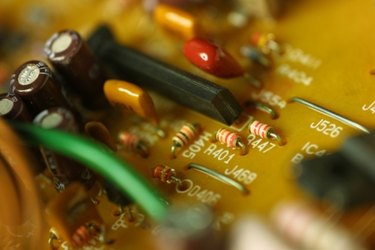
In electronics, amps and joules are two different but related units of measurement. Understanding the difference between amps, volts, ohms and joules is the first key to building your own circuits. Luckily, an everyday analogy can help clarify these concepts.
What Is an Amp?
Video of the Day
An amp, or ampere, is the standard way to measure electrical current. It is defined as the amount of current needed to transport one coulomb of electric charge per second. One way to think of these terms is to imagine molasses running through a garden hose. The amperage is the rate the molasses is flowing. A coulomb is the amount of molasses passing through the hose in one second.
Video of the Day
What Is Voltage?
To understand the difference between an amp and a joule, you need to understand voltage. Voltage is the difference between the number of electrons in one place and the number in another. Imagine that you have not yet turned on the hose full of molasses. There is a lot of molasses waiting to come out the spigot, but none at the other end. The difference between the full end and the empty end is the potential energy. This is voltage.
What Is Resistance?
Now imagine that there is a series of kinks in the garden hose making it more difficult for the molasses to flow. This is resistance is measured in ohms.
One useful way to understand the relationship between current, voltage, and resistance is Ohm's Law. It is expressed as E=IR where E equals voltage, I is current and R equals resistance. Put differently, the flow of molasses depends on the pressure at the spigot (voltage) and on the number of kinks in the hose (resistance).
What Is a Joule?
A joule is a unit of energy or work. One joule is the work needed to move one ampere through one ohm of resistance for one second. In the example, energy will be required to pump the molasses past the kinks and out through the end. This energy could be supplied by a battery (in a circuit) or by a person riding a stationary bike (in the yard). The amount of energy needed to keep the molasses flowing at a rate of one coulomb per second is a joule. The production of one joule per second is one watt.
Amps vs. Joules
Amperes cannot be converted to joules, because they are two different units. One is current (molasses flow) and the other is work (bicycling). However, there is a relationship between them. To find it, you must know the amperage, the voltage, and the wattage (number of joules per second). The wattage is the amperage times the voltage. This means that the work required by the cyclist is the amount of flow times the length of the hose.
- "Basic Electronics"; Voltage; James F. Young; 2000
- Articles About 'Electricity': New Explanations, Alternate Mental Tool Kit; How Are Watts, Ohms, Amps, and Volts Related?; William J. Beatty; 2000
- Articles About 'Electricity': New Explanations, Alternate Mental Tool Kit; What Is Voltage?; William J. Beatty; 1998
- "All About Circuits"; Chapter 2: Ohm's Law: How Voltage, Current, and Resistance Relate; Tony R. Kuphaldt et al
- Encyclopedia Britannica: Joule
- Articles About 'Electricity'; How Are Watts, Ohms, Amps, and Volts Related?; William J. Beatty; 2000
- "HyperPhysics"; DC Electric Power; C.R. Nave; 2010